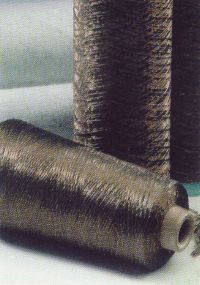
| ||||||||||
 |
Kindly note that this product is no longer in our program. Swicofil will try to find a suitable alternative.
The company markets modified fibers of polyamide (6.6) and polyester, with both anti-static and anti-bacteria properties. Applications are in protective clothing, air filtration non-wovens, bedding, shoes linings and sports apparel… The accumulation of electrostatic charges on a cloth (or on any other material) can lead, when they are earthed, to disagreeable electric shocks for the person, to problems with small electronic equipment, to the destruction of sensitive electronic elements during their manufacture, and also to fires and explosions caused by sparks from the electric arc. One solution to these problems is to convert the materials into conductors by incorporating conductive or antistatic fibers. There are several techniques for doing this:
Each solution has its advantages and inconveniences with regard to various criteria such as length of life, performances, cost and/or colour of the end product. The fibers are polyamide 6.6 or HT polyester fibers covered with a coating of copper sulphide of 0.2 microns, and intimately linked to the polymer by occlusion. They offer both long-lasting electrical conductivity and anti-bacteria properties. In addition they retain the textile characteristics of the polyesters and polyamides.
The linear electrical conductivity of the fibers is 104 to 105 O/cm., which places them between the purely conductor fibers and carbonaceous fibers. They conserve this conductivity over several years under the normal environmental conditions of humidity, temperature and exposure to light. As far as ageing is concerned, the antistatic properties are still present after 800 hours at 60°C and r.h. 70%. For abrasion, fibers’ properties are not impaired after 1’000 rubbings on a steel or ceramic rod (under 1 gr./dtex tension). Fibers resist to dyeing conditions (one hour, 130°C, pH 4), to dry cleaning with common solvents and to washing (twenty-five washings at 60°C for the single fibers, fifty washings at 70°C on blends containing 2.5% of stainless steel fibers). Elongation does not affect static properties, this until break. The fibers are used in the manufacture of protective clothing, floor- and wall-coverings, blankets, belts, with the antistatic functions acquired as from just 2% fiber (or filament) content in the blend, a percentage which may vary as a function of the construction and end-use. Filtration of hot gasses requires a polyester polymer conductive fiber for use at continuous temperatures up to 170°C (variation of 104 to 106 O/cm. after ten weeks). Incineration fumes have a high acid component (HCI, H2SO4), but resistance to acid hydrolysis has been demonstrated through soaking a non-woven sample (3%, P type) in an aqueous solution (H2SO4, 2% in mass and FeSO4, 20g/l), then oven drying at 130°C. This test is repeated twenty times.
The anti-bacteria mechanism action is explained by the progressive liberation of the copper ions, which affect the external membrane of the bacteria and block their respiratory capacities, and thus prevent their breeding. This effect is operative from just 2 to 3% fiber content in the textile blend. This anti-bacteria property has been subject to positive testing by the Institut Pasteur and the Manchester BTTG labs. The main application targeted by the fibers is bedding, but also clothing and under-clothing, sports articles, shoes linings, socks/stockings.
Polyamide fibers are supplied in 3.3, 6.7, 11 and 17 decitex in 30 to 80 mm lengths, polyesters in 5
decitex, lengths 30 to 50 mm. They are supplied as raw material, rovings, tops, staple yarns (100% or blends). Polyamide 6.6 22 dtex monofilaments, as well as polyester 1670 dtex/f200
multifilament yarns, have been developed and are submitted to industrial trails at the moment.
| |||||||||
| Be notified of page updates |
wwwswicofilcom2015

 R-Stat
R-Stat